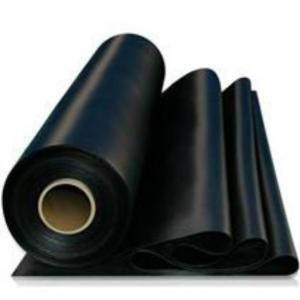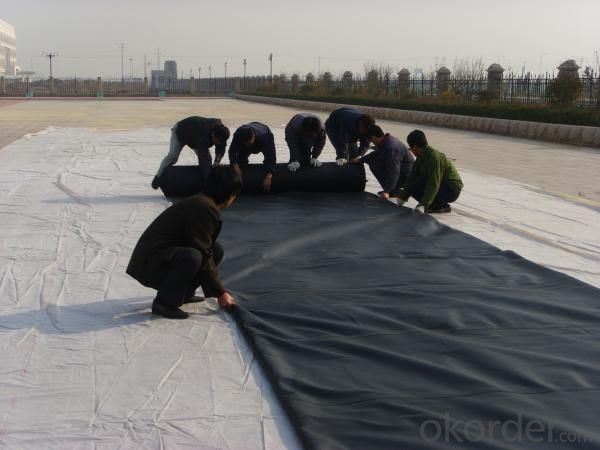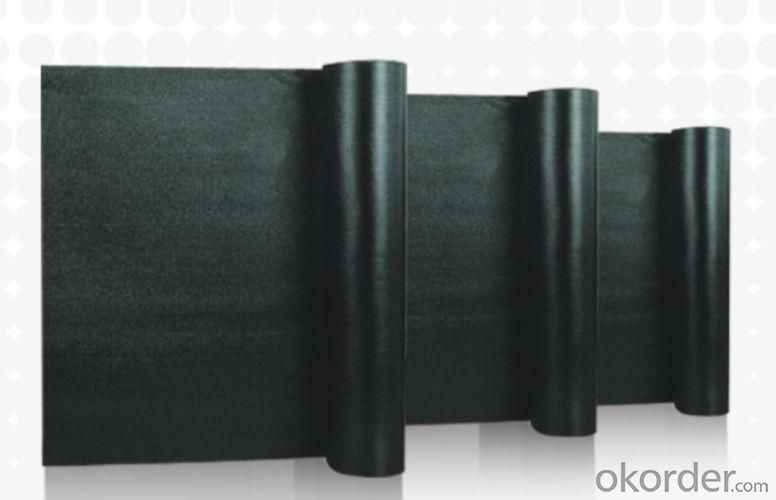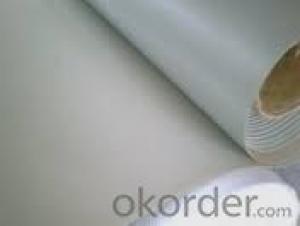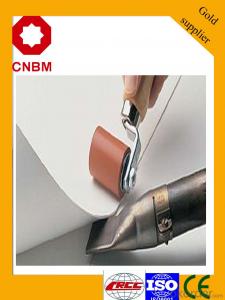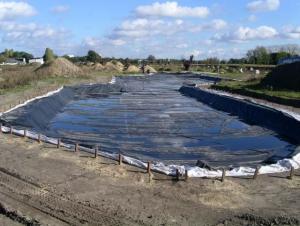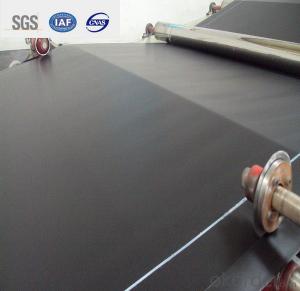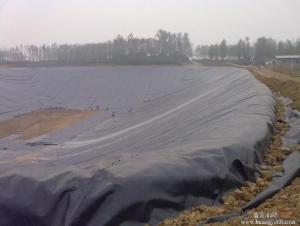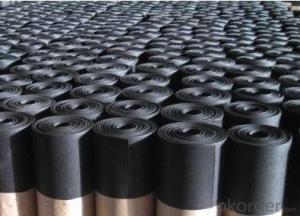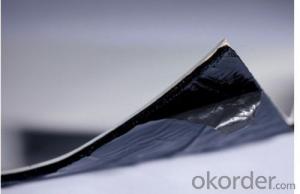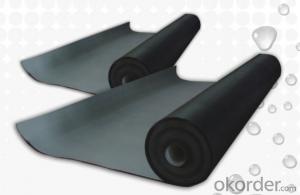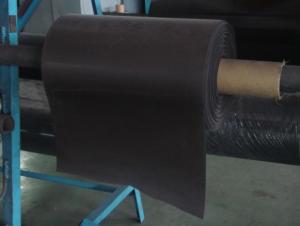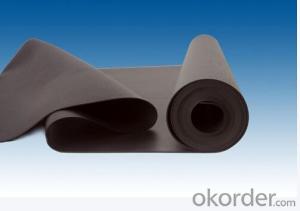EPDM Waterproof Membrane For Roofing
- Loading Port:
- Qingdao, China
- Payment Terms:
- TT or LC
- Min Order Qty:
- 2000 M2 m²
- Supply Capability:
- Above 10000000M2 Per Year m²/month
OKorder Service Pledge
OKorder Financial Service
You Might Also Like
Detailed Specification for EPDM Waterproof Membrane:
|
Type |
EPDM Waterproofing Membrane | |||
|
Material |
EPDM Rubber | |||
|
Thickness |
1.0mm |
1.2mm |
1.5mm |
2.0mm |
|
Size |
1.2m(width) * 20m(length)/roll, Weldale could 4m width | |||
|
Type |
Vulcanized & Weldable | |||
|
Pattern |
Non-reinforced(homogeneous) | |||
|
Packing |
24sqm--80sqm/roll, with plastic bag | |||
|
Color |
Black | |||
|
Application |
Roof, basement, pond, Lake, steel structure roof, swimming pool, underground, tunnel, etc | |||
Product Features of EPDM Waterproofing Membrane:
1. the excellent anti-aging, in the long term light, humidity, cold use of the natural
environment, small changes in physical properties, used in the temperature:
From -50 degree Celsius to +80degree Celsious.
2.with outstanding ozone resistance, resistance to ultraviolet and atmospheric corrosion
of many chemical corrosive substances.
3. high tensile strength, high elongation, high flexibility, capable of sustaining
a puncture of hard material, good anti-crack, high adaptability of the grass roots'
contraction and the crack and deformation, and give full play to extend the
performance, playing the role of waterproofing.
4.long lifetime, high durability can achieve more than 25 years.
5.the cold construction operation, no environment pollution and simple operation.
Application Pictures of EPDM Waterproof Membrane:
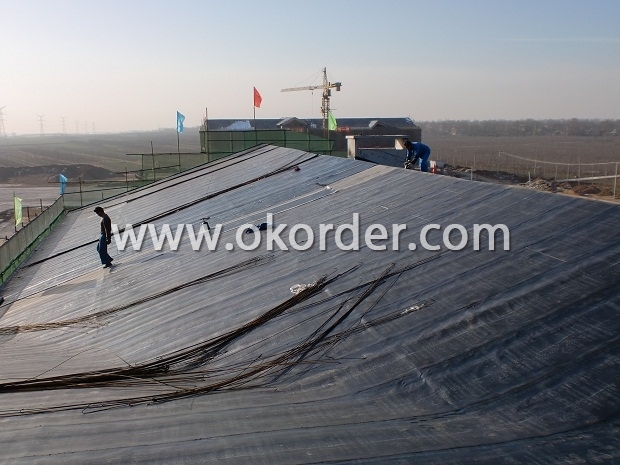
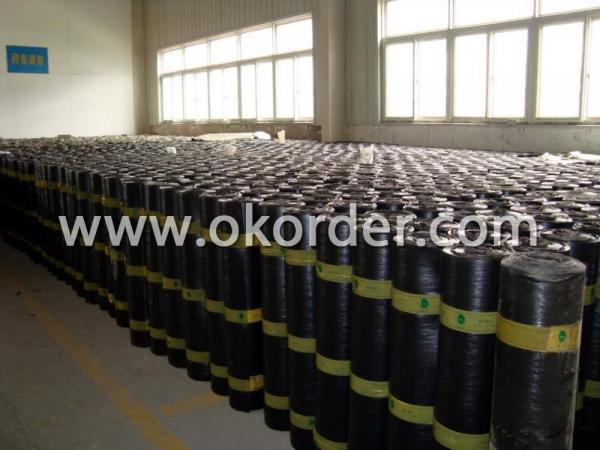
- Q: Are waterproofing membranes resistant to extreme weather conditions?
- Yes, waterproofing membranes are designed to be resistant to extreme weather conditions. These membranes are typically made from durable materials like rubber, PVC, or modified bitumen that can withstand the effects of harsh weather such as heavy rain, snow, strong winds, and extreme temperatures. They are engineered to be flexible, yet strong, ensuring that they can effectively protect structures from water infiltration even in the most challenging weather conditions. Additionally, waterproofing membranes are often treated with UV stabilizers to prevent damage caused by prolonged exposure to the sun's rays. Overall, these membranes provide reliable and long-lasting protection against extreme weather conditions.
- Q: Is a waterproofing membrane resistant to mold and mildew growth?
- Indeed, the resistance of a waterproofing membrane to the growth of mold and mildew stems from its specific design, which aims to establish a barrier against moisture infiltration. This impedes water seepage and the subsequent development of mold and mildew. Through the effective sealing of the area, these membranes eradicate the favorable conditions for the proliferation of mold and mildew, such as dampness and moisture. However, it is important to acknowledge that although the membrane itself exhibits resistance to mold and mildew growth, it does not guarantee absolute protection against these issues. Proper installation, regular maintenance, and ensuring adequate ventilation play pivotal roles in preventing the long-term growth of mold and mildew.
- Q: Can waterproofing membranes be used on retaining walls?
- Yes, waterproofing membranes can be used on retaining walls. These membranes are designed to prevent water penetration and can help protect the retaining wall from moisture damage.
- Q: Can a waterproofing membrane be used in roofs?
- Roofs can indeed benefit from the use of a waterproofing membrane. It's a widely employed technique for safeguarding roofs against water-related harm. Typically composed of robust materials like rubber or modified bitumen, this membrane is applied to the roof's surface to establish a barrier that prevents water from seeping through. As a result, leaks and potential damage are averted, as this protective layer stops water from penetrating the roof's underlying structure. Waterproofing membranes are particularly advantageous for flat or low-sloped roofs, where water accumulation is prone to causing issues. Moreover, these versatile membranes can be utilized on diverse roofing materials, including concrete, metal, and asphalt, making them suitable for various roof types. Overall, incorporating a waterproofing membrane into roofs effectively enhances their durability and longevity, while ensuring dependable protection against water infiltration.
- Q: Can a waterproofing membrane be used on precast brass surfaces?
- No, a waterproofing membrane cannot be used on precast brass surfaces. Brass is a non-porous material, therefore it does not require waterproofing.
- Q: Can a waterproofing membrane be used on retaining walls?
- Yes, a waterproofing membrane can be used on retaining walls. Retaining walls are often exposed to moisture and hydrostatic pressure, which can lead to water infiltration and deterioration of the structure. Applying a waterproofing membrane on the retaining wall can help prevent water penetration, protect the wall from moisture-related damage, and prolong its lifespan. The membrane acts as a barrier, preventing water from seeping into the wall and causing potential issues such as efflorescence, cracks, or erosion. It is important to choose a waterproofing membrane that is specifically designed for below-grade applications and is capable of withstanding the pressure exerted by the retained soil. Additionally, proper installation techniques and appropriate drainage systems should be considered to ensure the effectiveness of the waterproofing membrane on retaining walls.
- Q: Can a waterproofing membrane be used in areas with heavy foot traffic or vehicle loadings?
- In high-traffic or heavy loading areas, it is possible to utilize a waterproofing membrane. Nevertheless, it is crucial to select a membrane specifically designed for such purposes in order to guarantee durability and longevity. These specialized membranes are typically thicker and more resistant to wear and tear. Furthermore, it is important to consider the type of traffic or loading that the area will endure. For instance, areas with vehicular traffic may necessitate a membrane with higher compressive strength to endure the weight of vehicles. In conclusion, the selection of the appropriate type of membrane that satisfies the specific demands of the application is of utmost importance when using waterproofing membranes in high-traffic or heavy loading areas.
- Q: Are waterproofing membranes resistant to efflorescence?
- Yes, waterproofing membranes are typically resistant to efflorescence. Efflorescence is the crystalline deposit of salts that can occur on the surface of materials like concrete or masonry when moisture migrates through them. Since waterproofing membranes create a barrier against moisture, they prevent the migration of water and consequently minimize the occurrence of efflorescence.
- Q: Can a waterproofing membrane be used on stone block surfaces?
- Yes, a waterproofing membrane can be used on stone block surfaces. The membrane creates a protective barrier that prevents water penetration and helps to maintain the integrity of the stone blocks. However, it is essential to ensure that the appropriate type of waterproofing membrane is selected and installed correctly to ensure proper adhesion and durability on the stone surface.
- Q: Does a waterproofing membrane provide any protection against radon gas?
- No, a waterproofing membrane does not provide protection against radon gas. Radon gas is a radioactive gas that can seep through building materials, including waterproofing membranes. To protect against radon gas, specialized radon mitigation systems are required.
1. Manufacturer Overview
| Location | Hebei, China |
| Year Established | 2003 |
| Annual Output Value | Above US$ 10 Million |
| Main Markets | Europe; North America; Africa; Asia |
| Company Certifications | ISO 9001 |
2. Manufacturer Certificates
| a) Certification Name | |
| Range | |
| Reference | |
| Validity Period |
3. Manufacturer Capability
| a) Trade Capacity | |
| Nearest Port | Tianjin; Qingdao |
| Export Percentage | 50% - 100% |
| No.of Employees in Trade Department | 6- 10 people |
| Language Spoken: | English; Chinese |
| b) Factory Information | |
| Factory Size: | 100000 Square meters |
| No. of Production Lines | Above 5 |
| Contract Manufacturing | OEM Service Offered; Design Service Offered |
| Product Price Range | |
Send your message to us
EPDM Waterproof Membrane For Roofing
- Loading Port:
- Qingdao, China
- Payment Terms:
- TT or LC
- Min Order Qty:
- 2000 M2 m²
- Supply Capability:
- Above 10000000M2 Per Year m²/month
OKorder Service Pledge
OKorder Financial Service
Similar products
Hot products
Hot Searches
Related keywords
